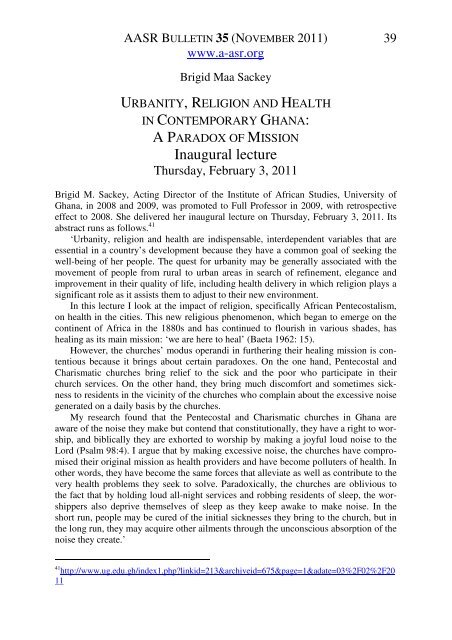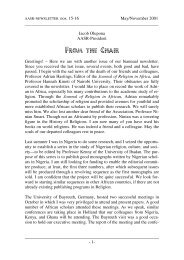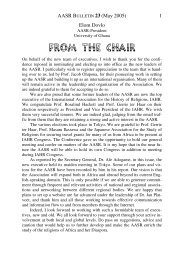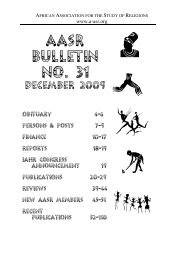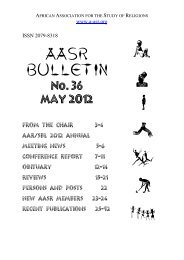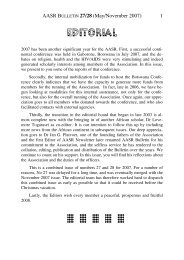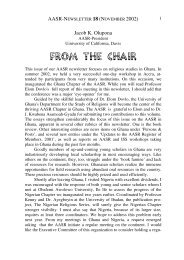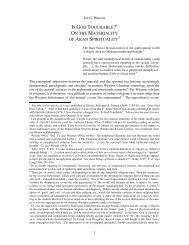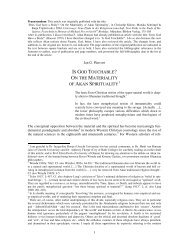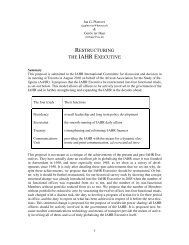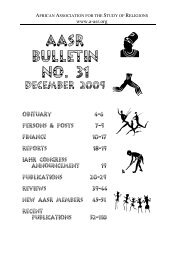AASR Bulletin 35 - The African Association for the Study of Religions
AASR Bulletin 35 - The African Association for the Study of Religions
AASR Bulletin 35 - The African Association for the Study of Religions
Create successful ePaper yourself
Turn your PDF publications into a flip-book with our unique Google optimized e-Paper software.
<strong>AASR</strong> BULLETIN <strong>35</strong> (NOVEMBER 2011)<br />
www.a-asr.org<br />
39<br />
Brigid Maa Sackey<br />
URBANITY, RELIGION AND HEALTH<br />
IN CONTEMPORARY GHANA:<br />
A PARADOX OF MISSION<br />
Inaugural lecture<br />
Thursday, February 3, 2011<br />
Brigid M. Sackey, Acting Director <strong>of</strong> <strong>the</strong> Institute <strong>of</strong> <strong>African</strong> Studies, University <strong>of</strong><br />
Ghana, in 2008 and 2009, was promoted to Full Pr<strong>of</strong>essor in 2009, with retrospective<br />
effect to 2008. She delivered her inaugural lecture on Thursday, February 3, 2011. Its<br />
abstract runs as follows. 41<br />
‘Urbanity, religion and health are indispensable, interdependent variables that are<br />
essential in a country’s development because <strong>the</strong>y have a common goal <strong>of</strong> seeking <strong>the</strong><br />
well-being <strong>of</strong> her people. <strong>The</strong> quest <strong>for</strong> urbanity may be generally associated with <strong>the</strong><br />
movement <strong>of</strong> people from rural to urban areas in search <strong>of</strong> refinement, elegance and<br />
improvement in <strong>the</strong>ir quality <strong>of</strong> life, including health delivery in which religion plays a<br />
significant role as it assists <strong>the</strong>m to adjust to <strong>the</strong>ir new environment.<br />
In this lecture I look at <strong>the</strong> impact <strong>of</strong> religion, specifically <strong>African</strong> Pentecostalism,<br />
on health in <strong>the</strong> cities. This new religious phenomenon, which began to emerge on <strong>the</strong><br />
continent <strong>of</strong> Africa in <strong>the</strong> 1880s and has continued to flourish in various shades, has<br />
healing as its main mission: ‘we are here to heal’ (Baeta 1962: 15).<br />
However, <strong>the</strong> churches’ modus operandi in fur<strong>the</strong>ring <strong>the</strong>ir healing mission is contentious<br />
because it brings about certain paradoxes. On <strong>the</strong> one hand, Pentecostal and<br />
Charismatic churches bring relief to <strong>the</strong> sick and <strong>the</strong> poor who participate in <strong>the</strong>ir<br />
church services. On <strong>the</strong> o<strong>the</strong>r hand, <strong>the</strong>y bring much discom<strong>for</strong>t and sometimes sickness<br />
to residents in <strong>the</strong> vicinity <strong>of</strong> <strong>the</strong> churches who complain about <strong>the</strong> excessive noise<br />
generated on a daily basis by <strong>the</strong> churches.<br />
My research found that <strong>the</strong> Pentecostal and Charismatic churches in Ghana are<br />
aware <strong>of</strong> <strong>the</strong> noise <strong>the</strong>y make but contend that constitutionally, <strong>the</strong>y have a right to worship,<br />
and biblically <strong>the</strong>y are exhorted to worship by making a joyful loud noise to <strong>the</strong><br />
Lord (Psalm 98:4). I argue that by making excessive noise, <strong>the</strong> churches have compromised<br />
<strong>the</strong>ir original mission as health providers and have become polluters <strong>of</strong> health. In<br />
o<strong>the</strong>r words, <strong>the</strong>y have become <strong>the</strong> same <strong>for</strong>ces that alleviate as well as contribute to <strong>the</strong><br />
very health problems <strong>the</strong>y seek to solve. Paradoxically, <strong>the</strong> churches are oblivious to<br />
<strong>the</strong> fact that by holding loud all-night services and robbing residents <strong>of</strong> sleep, <strong>the</strong> worshippers<br />
also deprive <strong>the</strong>mselves <strong>of</strong> sleep as <strong>the</strong>y keep awake to make noise. In <strong>the</strong><br />
short run, people may be cured <strong>of</strong> <strong>the</strong> initial sicknesses <strong>the</strong>y bring to <strong>the</strong> church, but in<br />
<strong>the</strong> long run, <strong>the</strong>y may acquire o<strong>the</strong>r ailments through <strong>the</strong> unconscious absorption <strong>of</strong> <strong>the</strong><br />
noise <strong>the</strong>y create.’<br />
41 http://www.ug.edu.gh/index1.phplinkid=213&archiveid=675&page=1&adate=03%2F02%2F20<br />
11


